Text
Chuseok (추석)
Hello everyone and welcome to 2021/22 ksoc! We hope you had a wonderful summer and are excited to join us this new academic year.
This week in Korea they will be celebrating the festival of Chuseok. Here will be some insight to what Chuseok is and what types of events take place!
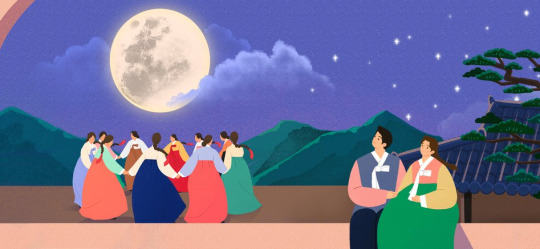
What is Chuseok and why is it celebrated?
Chuseok (추석) which translates to “Autumn Eve” is a major holiday and harvest festival, celebrated across three days in Korea. In accordance with the Lunar calendar, Chuseok (also known as Hangawi) is celebrated on the 15th of the 8th month; This takes place around September in the Gregorian calendar. This year, Chuseok falls on Tuesday 21st September.
Chuseok is known as The Harvest Moon Festival and includes agricultural traditions. It is taught that on this day, families gather together to honour their ancestors and thank them for the ample harvest.

Chuseok is used as a time for families to give thanks to their ancestors, in which its traditions date back thousands of years. It is widely believed that the origin dates back to the third king of Silla ( 신라 ), who requested for two teams to compete in a weaving contest, in which the winning team would be rewarded with a banquet.
There are many traditions that are still practiced today, such as Charye (차례). Charye refers to when families set out food and incense, thought to gain access to blessings from ancestors that have passed. Examples of offerings include makgeolli (막걸리), which is a traditional Korean drink made from harvested rice.

Other modern events and offerings during Chuseok
Chuseok is known as one of the busiest times in Korea as people travel across the country to be with their families in time for the festival. There are many traditional Chuseok dishes that are enjoyed by families including Songpyeon (송편) and Japchae (잡채). Songpyeon are rice cakes that are shaped like half-moons with various different fillings. Japchae is a dish consisting of stir-fried vegetables and sweet potato noodles, which is commonly served as a side dish.
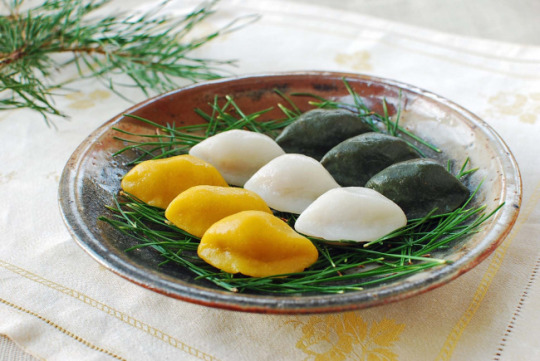

Another practiced tradition is the act of gift-giving. People will present not only their families but friends with gifts to give thanks. The gifts range from a variety of things such as cash, fruits, high-quality beef, and red ginseng, to daily necessity products such as soap. These gifts are often nicely packaged and sold in stores for the celebration.

For more information on the festival of Chuseok, please take a look at the linked articles and pages!
We wish a very happy Chuseok to those who are celebrating. 즐겁고 행복한 추석 보내시길 바랍니다!
Other resources:
https://chuseok.org/chuseok-a-korean-thanksgiving/
https://asiasociety.org/korea/chuseok-korean-thanksgiving-day
Images used:
https://kccuk.org.uk/en/programmes/korea-day/chuseok-festival-2021/
https://www.korea.net/NewsFocus/HonoraryReporters/view?articleId=175313
https://www.eater.com/drinks/2017/2/20/14645442/makgeolli-korean-rice-wine
http://www.koreaherald.com/view.php?ud=20130913000842
https://www.angsarap.net/2012/01/18/japchae/
https://koreajoongangdaily.joins.com/2021/09/09/business/economy/chuseok-gift/20210909164500584.html
References:
https://archive.md/20130221010349/http://www.visitkorea.or.kr/enu/SI/SI_EN_3_6.jsp?cid=613421
https://atkmagazine.com/2015/09/28/korean-history-101-chuseok-%EC%B6%94%EC%84%9D/
http://english.visitkorea.or.kr/enu/ATR/SI_EN_3_6.jsp?cid=811650
https://asiasociety.org/korea/chuseok-korean-thanksgiving-day
https://chuseok.org/chuseok-a-korean-thanksgiving/
2 notes
·
View notes
Text
국립공원 - National Parks (part 2)

Juwangsan National Park - 주왕산국립공원
107.42km2
Part of the Taebaek mountain range
As with most of South Korea’s parks there are temples such as Daejeonsa temple to be found
Jusanji lake is a popular photography and tourist spot since it was used as a location in the film ‘Spring, Summer, Autumn, Winter and Spring’
Every year during the first week of May the Juwangsan Royal Azalea Festival is held here

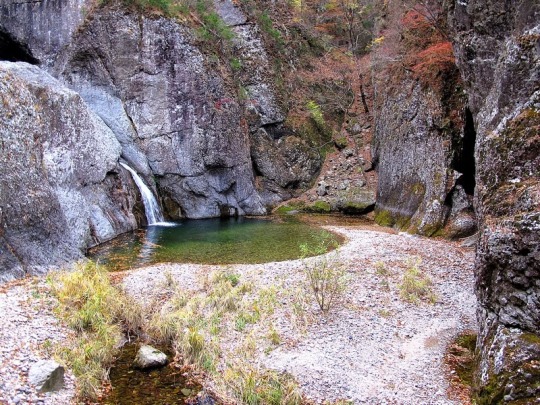
Mudeungsan National Park - 무등산국립공원
75.45km2
There are 61 naturally formed viewpoints along the trails
Many temples (some still inhabited by monks!) lie throughout the park
Column rock formations similar to the giants causeway are particularly noticeable here
Over 2200 animal species have the park as a habitat - including endangered species such as Eurasian otter, manchurian black water snake, yellow-throated martens and leopard cats


Naejangsan National Park - 내장산국립공원
81.45km2
The park is well known for maple leaves in the autumn, with up to 100,000 visiotors a day for the “red carpet event”
Naejang temple and Baekyangsa temple are among the many that can be found within the park
Uhwajeong pavilion is the source of a legend that the pavilion once grew wings and ascended into the skies, now it sits on a lake as a popular photography spot
Yeonjabong Peak has an observatory that can be accessed via cable car or hiking trail
Hiking trails cater to all abilities unlike some other parks

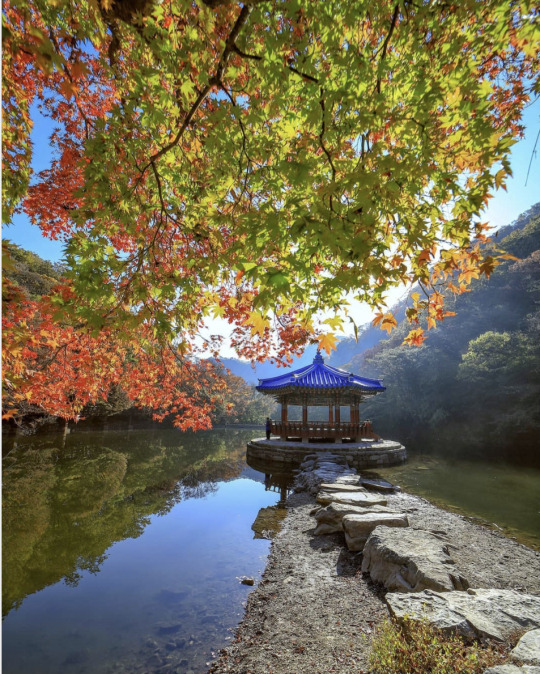
Odaesan National Park - 오대산국립공원
303.93km2
There are 5 major peaks in the area, split by plains which give the park is name of “5 plains mountain”
The area is known for its wild ginseng growth and the water from rivers and streams is believed to have curative effects
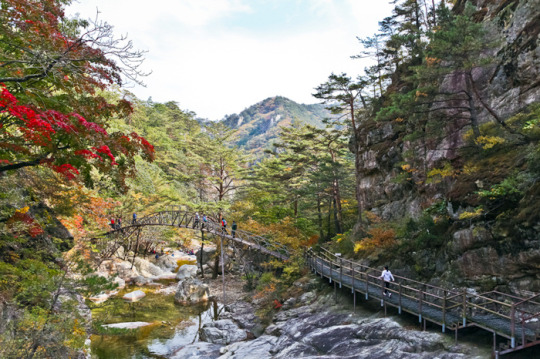

Seoraksan National Park - 설악산국립공원
The first national park to be defined under law
398.22km2
A UNESCO Biospehere reserve and a UNESCO world heritage site
An area of 163.6km2 is designated as a nature reserve
Gongnyong ridge/dinosaur ridge is widely regarded as the most scenic spot in Korea and as such is popular with sightseers and hikers however the route through the ridge is strenuous and takes around 13 hours to complete which also makes it the site of many accidents among visitors
The park is valued for its diversity of flora and fauna with over 1000 species known to be in the area
Two buddhist temples Baekdamsa Sinheungsa can be found in the park



Sobaeksan National Park - 소백산국립공원
322.38km2
A reintroduction program for Korean foxes in the area has raised their population to 50 and plans to continue
There are plenty of hiking trails and campsites for those who wish to explore the area
Darian falls and Gosu caves are popular tourist spots

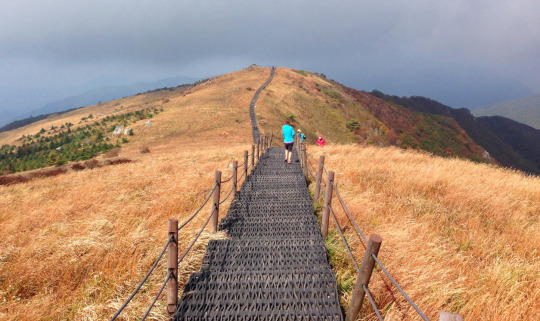
Songnisan National Park - 속리산국립공원
274.54km2
Located in the centre of the Sobaek mountain range
It’s name means “Remote from the Ordinary World” which is in reference to it’s isolated position in the centre of South Korea away from major cities
There are hiking trails in the park that attract 1.5 million visitors every year

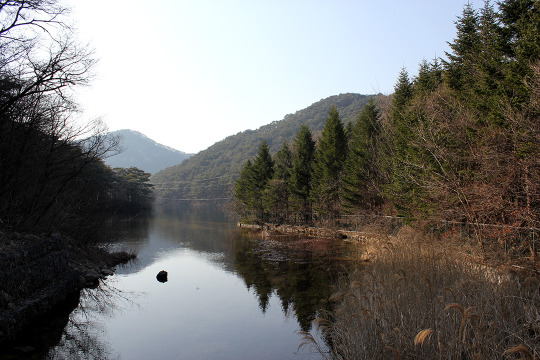

Taean Seaside National Park - 태안해안국립공원
840km2
The park has a varied coastline including beaches, dunes, rocky formations and small islands
This variety has enabled 671 marine species to live there, including minke whales and Eurasian porpoises

Taebaeksan National Park - 태백산국립공원
70.052km2
The highest peaks are home to Cheonjedan, a series of shamanistic altars
At Danggol there is a yearly snow festival and coal mining museum
Manggyeongsa temple is a buddisht temple built to enshrine the Bodhisattva of wisdom and boasts the highest spring in South Korea at its entrance, named the Dragon Spring


Wolchulsan National Park - 월출산국립공원
At 56.6km2 this is South Korea’s smallest national park
3 national treasures lie within the park - Dogapsa temple, Wochulsan Seated Buddha and
Wolchulsan Sculpture Park provides a different tourist destination to the hiking trails and temples so common at every national park
The Cloud Bridge is a brightly coloured suspension bridge that is 52m long and 120m above the ground that provides an excellent spot for pictures and is accessible by a short if slightly challenging 1.6km hike
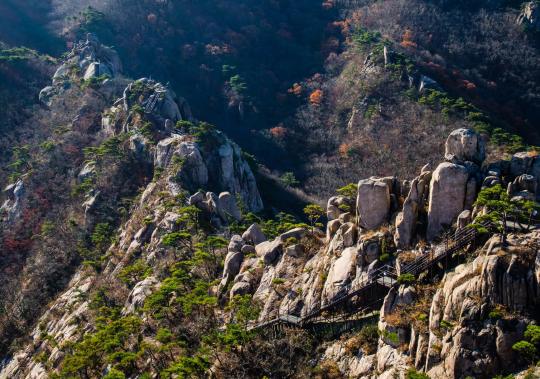

Woraksan National Park - 월악산국립공원
287.78km2
There are over 22 mountains within the park with Yeongbong being the tallest at 1097m
Another park popular for hiking and scenic views there are visitors throughout every season
Buddhist sites such as Deokjusa temple and Maaebul Rock can also be found throughout


As you can see, Korea has a lot to see in terms of natural beauty and historical sites and has something for everyone right across the country!
Researched and posted by Leo :)
Bibliography
https://www.hikegeoje.com/woraksan-national-park
https://en.wikipedia.org/wiki/Juwangsan_National_Park
https://thesoulofseoul.net/2013/11/22/a-hidden-lake-thats-not-so-hidden-anymore/
https://en.wikipedia.org/wiki/Mudeungsan_National_Park
https://tour.gwangju.go.kr/eng/tour/info/nature.cs?act=view&infoId=360&searchCondition=&searchKeyword=&pageIndex=2
https://en.wikipedia.org/wiki/Naejangsan_National_Park
https://en.wikipedia.org/wiki/Naejangsan
https://medium.com/@KKdayIntl/travel-korea-hike-koreas-maple-leaf-paradise-naejangsan-national-park-in-autumn-b97cac30bc70
https://en.wikipedia.org/wiki/Odaesan_National_Park
https://www.frommers.com/destinations/odaesan-national-park
https://en.wikipedia.org/wiki/Seoraksan_National_Park
https://en.wikipedia.org/wiki/Gongnyong_Ridge
https://en.wikipedia.org/wiki/Sobaeksan_National_Park
https://travelexx.com/hiking-in-sobaeksan-national-park-birobong-peak/
https://en.wikipedia.org/wiki/Songnisan_National_Park
https://en.wikipedia.org/wiki/Taeanhaean_National_Park
https://en.wikipedia.org/wiki/Taebaeksan
https://en.wikipedia.org/wiki/Wolchulsan_National_Park
https://oceanstoalpines.com/wolchulsan-national-park/
https://en.wikipedia.org/wiki/Woraksan_National_Park
https://english.knps.or.kr/Knp/woraksan/Intro/Introduction.aspx?MenuNum=1&Submenu=Npp
Pictures
https://www.tripzilla.com/kto-national-parks-in-korea/80106
https://www.hikegeoje.com/woraksan-national-park
https://gotravelyourworld.com/hiking-wolchulsan-national-park-south-korea/
https://en.wikipedia.org/wiki/Taebaeksan#/media/File:Taebaeksan_main_peaks_from_Munsubong.jpg
http://www.koreaherald.com/view.php?ud=20150123001062
https://www.inspirock.com/south-korea/taean-gun/taeanhaean-national-park-a4144608659
https://groovybowsequence.com/2013/04/24/songnisan-national-park/
https://klimbingkoreanmountains.wordpress.com/2013/10/17/songnisan-national-park-%EC%86%8D%EB%A6%AC%EC%82%B0/
https://klimbingkoreanmountains.wordpress.com/2014/10/21/sobaeksan-national-park-%EC%86%8C%EB%B0%B1%EC%82%B0/
https://www.koreaetour.com/odaesan-national-park/
https://thereshegoesagain.org/odaesan-national-park-korea/
https://klimbingkoreanmountains.wordpress.com/2014/04/29/mudeungsan-national-park-%EB%AC%B4%EB%93%B1%EC%82%B0/
https://www.koreattrack.com/exploring-mudeungsan-national-park.html
https://thesoulofseoul.net/2013/11/21/juwangsan-national-park-beauty-intrigue/
https://groovybowsequence.com/2014/08/11/juwangsan-national-park/
https://theculturetrip.com/asia/south-korea/articles/a-guide-to-visiting-seoraksan-national-park-south-korea/
https://www.vviptravel.com/tours/seoraksan-day-trip
https://www.koreattrack.com/naejangsan-national-park.html
https://www.instagram.com/p/B5SR2IlAubn/?utm_source=ig_embed
0 notes
Text
국립공원 - National Parks (part 1)
There are 22 national parks in South Korea and all of them except Hallasan are monitored by the Korea National Park service. For context, the UK as a whole has just 14 official declared parks (and one that holds equivalent status) but South Korea is roughly the size of England alone.
The post this week is about 11 of the parks, then next week the post will be about the remaining 11.

Bukhansan National Park - 북한산국립공원
Name translates as “north of han river”
The park lies within the boundaries of Seoul
79.92km2
Bukhansanseong fortress is located within the park
Popular destination for walkers so trails are closed on a rotational basis in order to protect the environment
There are three main peaks in the park which have for many years been known as Bukhansan however there is a movement to have the name changed back to the original Samgaksan which means three horned mountains
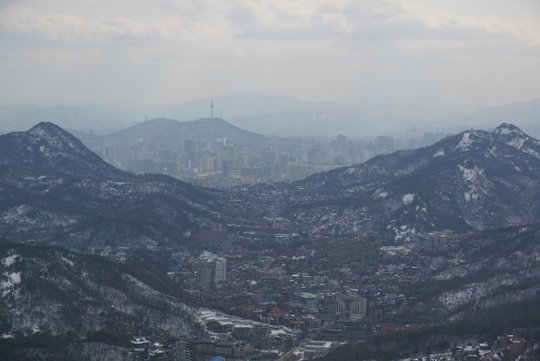
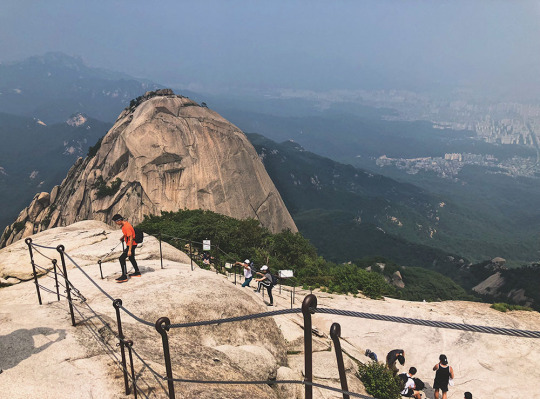
Byeonsan-bando National Park - 변산반도국립공원
The only park with a mix of mountains and maritime area
154.71km2 (9.27km2 of this is sea)
996 animal species and 877 plant species can be found here
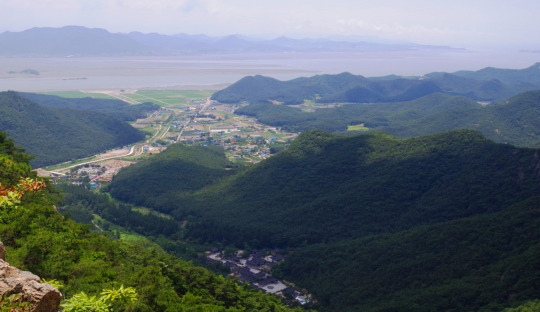
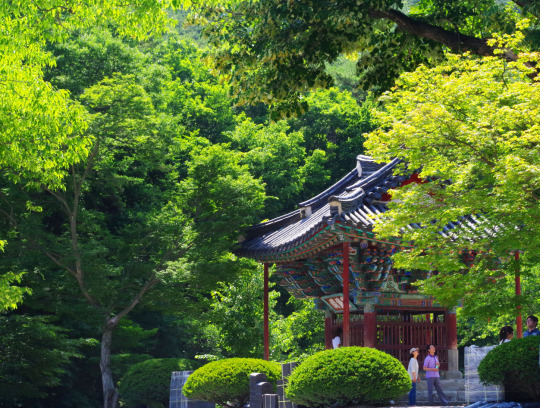
Chiaksan National Park - 치악산국립공원
181.57km2
34 endangered animal species can be found here, including the flying squirrel and hodgson’s bat
Named after Mount Chiaksan (formerly Jeokakasan) which means “pheasant peak mountain”, from the myth of a man who saved a pheasant from a snake.
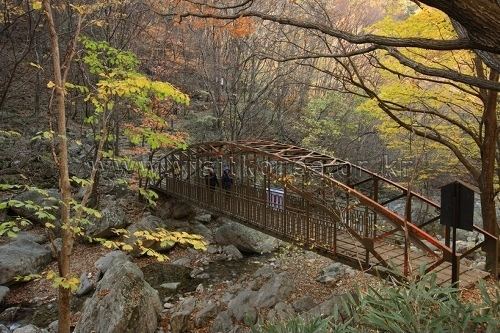
Dadohaehaesang National Park - 다도해해상국립공원
2321.5km2
The small islands of Hongdo and Heuksando are popular tourist destinations
Orca and porpoises can often be seen


Deogyusan National Park - 덕유산국립공원
231.65km2
The deogyusan mountain after which the park is named has attractions such as Chiryeon waterfall and Cheoksan mountain fortress
Also famous for the ski resort of Muju
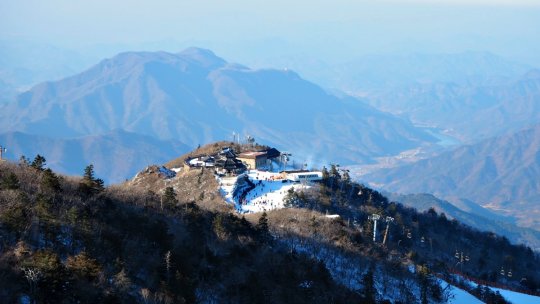
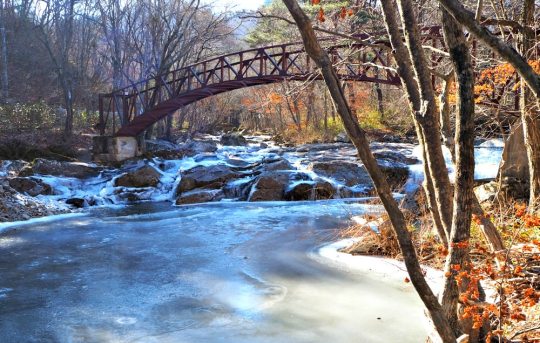
Gayasan National Park - 가야산국립공원
167.6km2
Haeinsa temple lies within the park
The Sobaek mountain range runs through the area of the park as well
Other attractions include Chilbubong peak, Yongmun falls and Hongnyudong valley
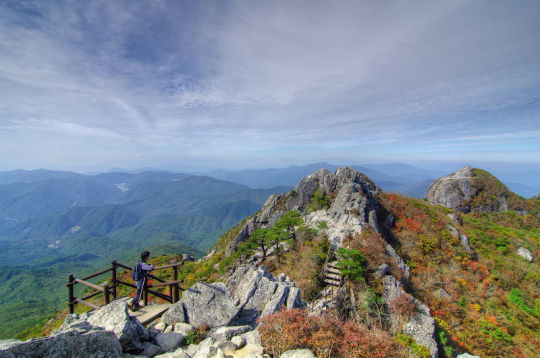
Gyeongju National Park - 경주국립공원
137.09km2
This is the only “historical park” in Korea
Many historical Silla sites can be found here

Gyeryongsan National Park - 계룡산국립공원
64.71km2
Only one part of the Gyeryongsan mountain lies within the park area
Gapsa temple can be found here
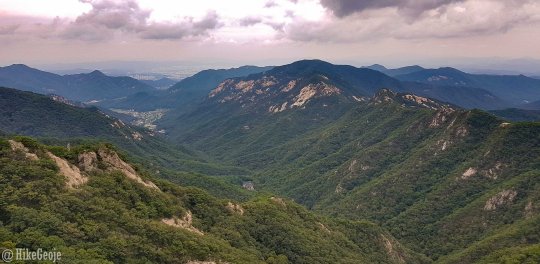
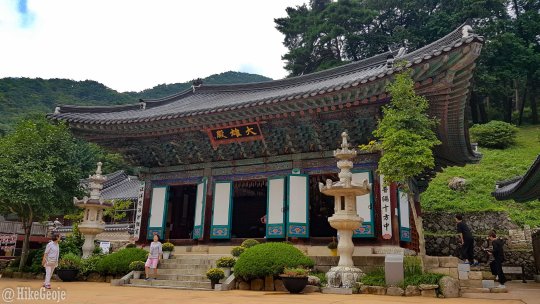
Hallasan National Park - 한라산국립공원
153.11km2
The national park of Jeju, this is why it is not managed by the Korea National Park service
The whole site sits on the shield volcano of Hallasan - in alternative english it is named Hanla mountain which means it is “high enough to pull the universe” (han meaning universe and la meaning pull”. This is likely where the belief that Gods and spirits live upon Hallasan came from
Hallasan is also the highest mountain in South Korea and has the Gwaneumsa temple built upon it
Both a UNESCO Biosphere reserve and UNESCO World Heritage Site
Many walking trails make this a popular place to visit
Baekrokdam crater lakes


Hallyeohaesang National Park - 한려해상국립공원
545.63km2
Also called the Hallyeohaesang National Park
Has a mixture of land and sea area but more than 50% is sea
Made up of many islands such as Namhae Island and its art villages, Goeje Island and Bijindo Island (each of these islands are their own unique locations that could have whole posts dedicated to them!)


Jirisan National Park - 지리산국립공원
471.75km2 makes it the largest land only national park in South Korea
Conservation programs are run throughout the park to reintroduce species
Hiking trails are much longer than some other parks and in a few cases they may take more than one day to fully complete (rest stops are available if booked ahead), park rangers are known to turn hikers back if they will be unable to reach their destination before then end of the day
Sanggyesa temple and Hwaeomsa temple are both accessible by a bus, and Cheoneunsa temple is one of the last places that houses the endangered wild pigeon
Buril waterfall is a popular tourist and photography spot
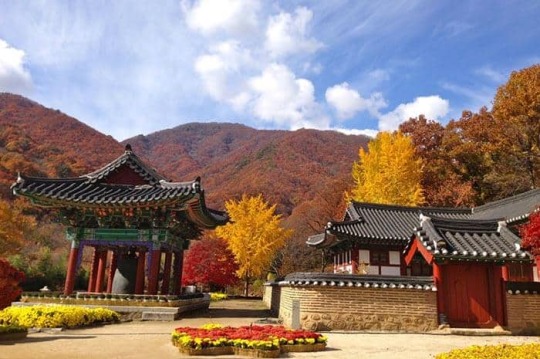
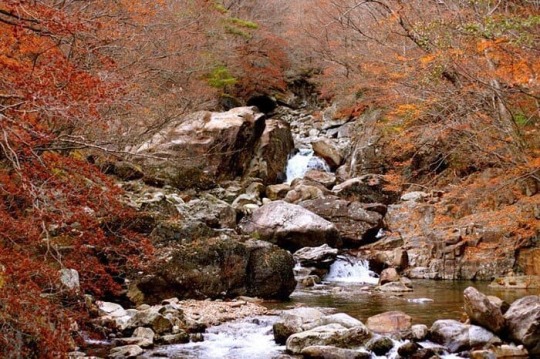
Researched and posted by Leo :)
Bibliography
https://klimbingkoreanmountains.wordpress.com/category/hiking-expeditions/south-korea/national-parks/jirisan-national-park-%EC%A7%80%EB%A6%AC%EC%82%B0/
https://en.wikipedia.org/wiki/List_of_national_parks_of_South_Korea
https://en.wikipedia.org/wiki/Bukhansan_National_Park
https://en.wikipedia.org/wiki/Byeonsan-bando_National_Park
https://en.wikipedia.org/wiki/Chiaksan_National_Park
https://en.wikipedia.org/wiki/Dadohaehaesang_National_Park
https://en.wikipedia.org/wiki/Deogyusan_National_Park
https://en.wikipedia.org/wiki/Gayasan_National_Park
https://en.wikipedia.org/wiki/Gyeongju_National_Park
https://en.wikipedia.org/wiki/Gyeryongsan_National_Park
https://en.wikipedia.org/wiki/Hallasan_National_Park
https://en.wikipedia.org/wiki/Hallasan
https://en.wikipedia.org/wiki/Hallyeohaesang_National_Park
https://en.wikipedia.org/wiki/Jirisan_National_Park
https://en.wikivoyage.org/wiki/Jirisan_National_Park
Pictures
https://en.wikipedia.org/wiki/File:South_Korea_adm_location_map.svg
https://www.gonomad.com/68787-korea-seeking-the-truth-in-jirisan-national-park
https://usicomos.org/sustaining-a-korean-traditional-rural-landscape/
https://www.triphobo.com/places/jeju-si-south-korea/hallasan-national-park
https://www.goingthewholehogg.com/hiking-hallasan/
https://www.hikegeoje.com/gyeryongsan-national-park
https://en.wikipedia.org/wiki/Gyeongju_National_Park
https://www.alltrails.com/trail/south-korea/gyeongsangbuk-do/mount-gayasan-and-manmulsang/photos
https://www.koreattrack.com/deogyusan-mountain-national-park.html
https://www.koreattrack.com/dadohaehaesang-national-park.html
http://amuraworld.com/en/topics/conservancy-report/articles/6429-dadohaehaesang-national-park
https://alchetron.com/Chiaksan-National-Park
https://klimbingkoreanmountains.wordpress.com/tag/byeonsanbando-national-marine-park/
https://www.viator.com/tours/Seoul/Bukhansan/d973-101420P2
https://www.lifestylust.com/hiking-in-bukhansan-national-park-in-seoul/
0 notes
Text
Tourist Destinations
Namsan Park
Miles of hiking trails
Set within Seoul
Namsan tower at the top of the mountain, overlooking Seoul
Namsangol hanok village
Cable car up the mountain
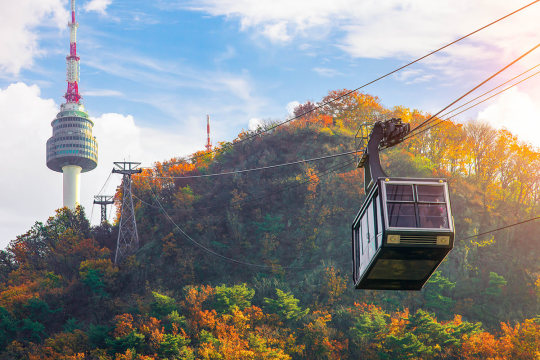
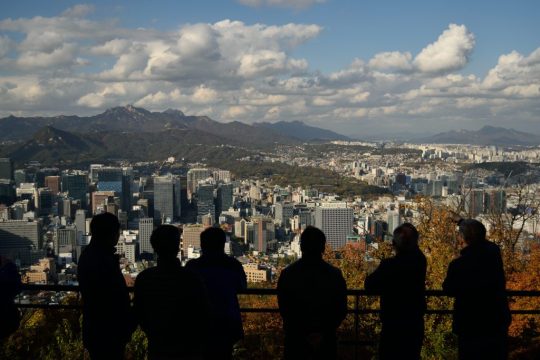

Changdeokgung Palace
99 Yulgok-ro, Waryong-dong, Jongno-gu, Seoul, South Korea
One of the best preserved historical sites in Korea
Huwon Secret garden was initially only open for royalty

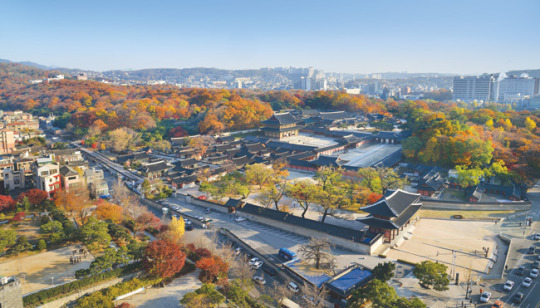

Gyeongbokgung Palace
161 Sajik-ro, Sejongno, Jongno-gu, Seoul
Also known as the Northern Palace
The Gyeonghoeru Pavilion and Hyangwonjeong Pond are two remaining structures from the Joseon Period
Two museums (national palace museum and national folk museum) within the grounds
Gwanghwamun gate used to be the opening in the fortress wall for the palace but has been moved and restored over the years
At the gate there is a changing of the guard ceremony every day except Tuesday at 10am and 2pm, which has been performed since 1469



Bukchon Hanok Village
Located within Gyeongbokgung Palace, in central Seoul (near Insadong)
Preserved or restored traditional Korean villages
Some of the hanoks are museums
There are often cultural demonstrations
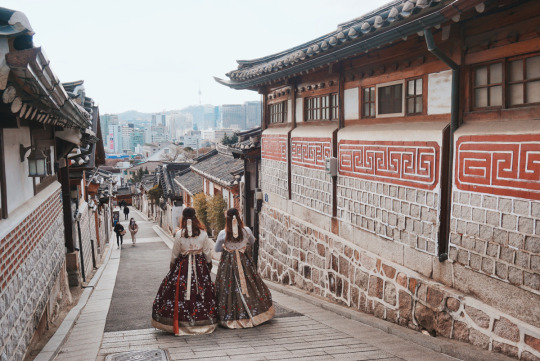
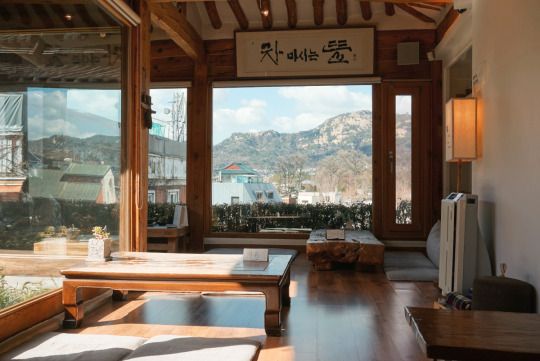

The DMZ
Demilitarised zone
No man's land that forms the border between North and South Korea
Can only be visited on guided tours
However surrounding areas have viewing platforms
Tourists can step over into north korea while in the cross border room
There is also a north korean gift shop




Lotte World
Songpa-gu, Jamsil 6(yuk)-dong, Olympic-ro, 300, Seoul
Amusement park in Seoul
As well as rides there is ice skating, shops, cultural demonstrations, movie theatres



Bulguksa Temple
15-1 Jinhyeon-dong, Gyeongju, Gyeongsangbuk-do
A Buddhist temple considered by many to be the country’s most important
Historic and scenic site number one, as classified by the government
Called a museum without walls
On the slopes of mount Toham in Gyeongju
The gardens are especially beautiful in spring
Located just outside of Busan
Approximately two and a half hours from Seoul via KTX
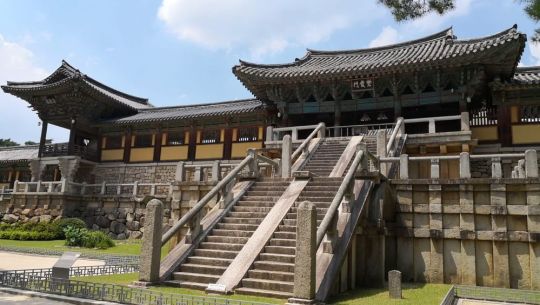
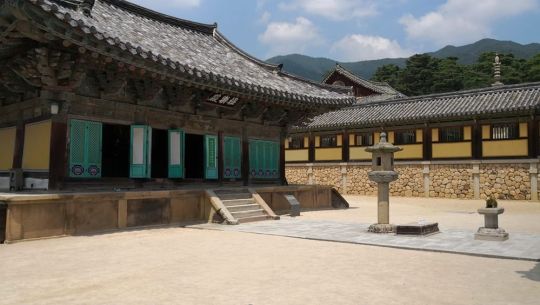
Hwaseong Fortress
320-2 Yeonghwa-dong, Jangan-gu, Suwon-si, Gyeonggi-do, South Korea
Originally built to surround Suwon (the capital of Gyeonggi province)
There are 4 gates set in almost 6 kilometres of walls
A UNESCO world heritage site
Every year the Suwon Cultural festival takes place, featuring re-enactments and cultural exhibits



Pocheon Art Valley
234, Art valley-ro, Sinbuk-myeon, Pocheon, Gyeonggi-do 11139 South Korea
Once a working quarry
Daily art workshops
A stage sometimes holds small concerts
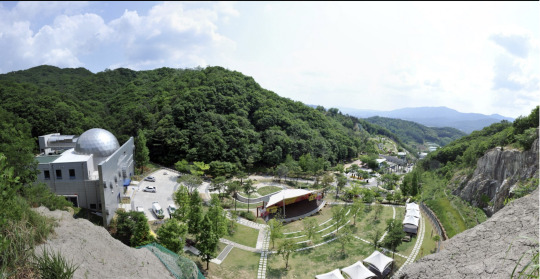
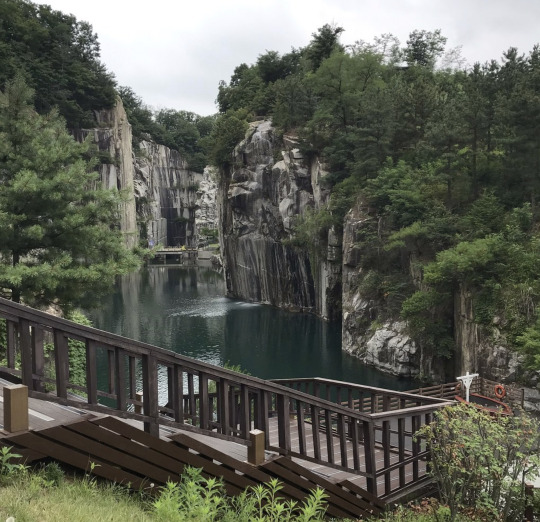
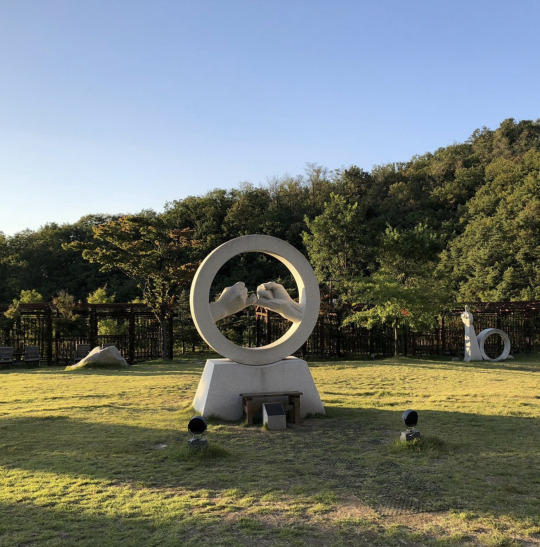
Gyeonghwa Station
648, Jinhae-daero, Jinhae-gu, Changwon, Gyeongsangnam-do 51669 South Korea
One of the locations in the Jinhae cherry blossom festival (there are many other spots for the festival but this one is popular year-round)
A top spot for photographers
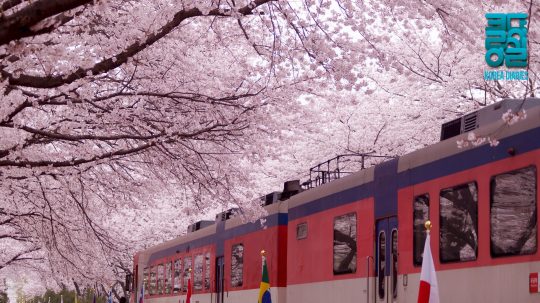
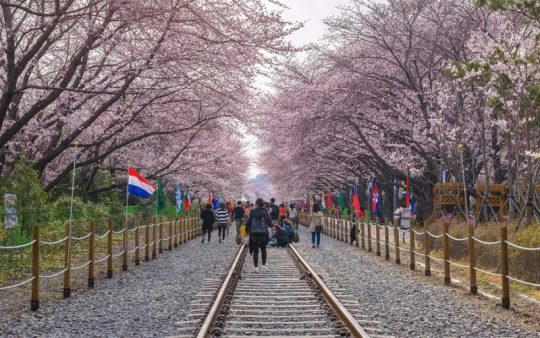
Researched and posted by Leo :)
Bibliography
https://www.touropia.com/tourist-attractions-in-south-korea/
https://www.planetware.com/south-korea/top-rated-tourist-attractions-in-south-korea-kor-1-4.htm
https://traveltriangle.com/blog/places-to-visit-in-south-korea/
Pictures
https://www.koreadiaries.com/10-tips-cherry-blossom-festival-jinhae-korea/
https://www.koreatraveleasy.com/2019/02/19/top-cherry-blossom-spots-in-korea-forecast-and-flowering-time/
https://www.tripadvisor.co.uk/Attraction_Review-g1074125-d3822080-Reviews-Pocheon_Art_Valley-Pocheon_Gyeonggi_do.html#photos;aggregationId=101&albumid=101&filter=7&ff=392630844
https://lostwithjen.com/suwon-hwaseong-fortress-in-south-korea-a-day-trip-from-seoul/
https://en.wikipedia.org/wiki/Hwaseong_Fortress#/media/File:Hwaseong_Fortress,_Suwon,_Gyeonggi-do,_Republic_of_Korea_(2).jpg
https://www.localguidesconnect.com/t5/Share-Your-Photos-and/Bulguksa-Temple-and-Seokguram-Grotto-Gyeongju-s-Sight-and-Sounds/td-p/981181
0 notes
Text
삼계탕 (samgyetang) - Ginseng Chicken Soup
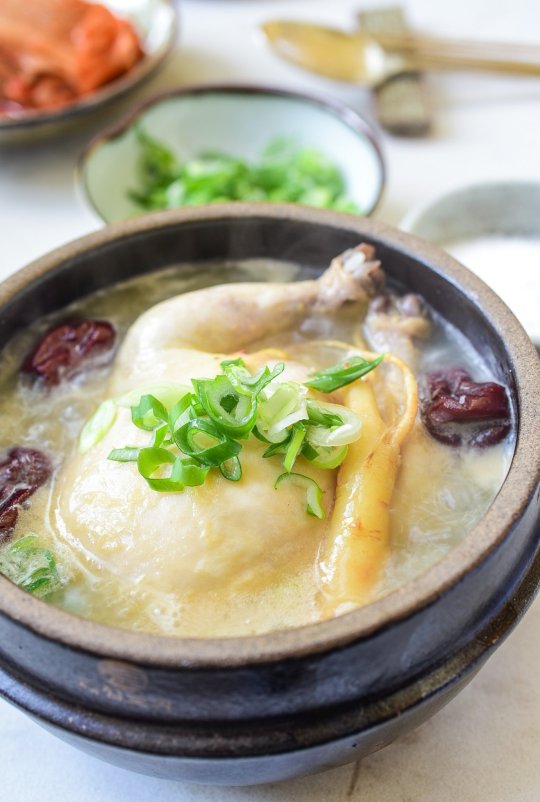
(serves 1)
Samgyetang is a popular summer dish in Korea and is often eaten on the three hottest days of the year. The hot soup is supposed to boost stamina and replenish energy, as well as overcoming the heat outside with the heat of the soup - Koreans call this 이열치열 (yi yeol yi cheol) which means “fight fire with fire”.
Typically, when you eat samgyetang you commit to eating a whole chicken (hence why the recipe only serves 1) though it’s understandable if you do wish to share!
Equipment
Big pot
Knife
Cutting board
Small dishes for dipping sauces if using
Ingredients
1 small chicken (may be called cornish hen but should weigh approx. 700grams)
1 ginseng root (either fresh or dried and rehydrated)
½ cup short grain rice
2 green onions
8 large garlic cloves
2 thin slices ginger (approx 1 inch chunk worth)
2 jujubes
5-6 cups water
(optional) ½ small onion
Optional sesame dipping sauce
1 teaspoon toasted sesame seeds
2 tablespoons toasted sesame oil
1 teaspoon salt
Pinch of black pepper
Optional sweet sour soy dipping sauce
3 tablespoons soy sauce
2 tablespoons white vinegar
1 teaspoon honey
1 green chilli
¼ diced onion
Instructions
Pat chicken dry
Stuff chicken with half the garlic and the rice minus one tablespoon)
Use one of the following methods to close the chicken
Cross legs and secure with twine and toothpick
Make a small hole in the skin between legs and cavity, tuck the end of the opposite leg in a then tuck the tail into the opening
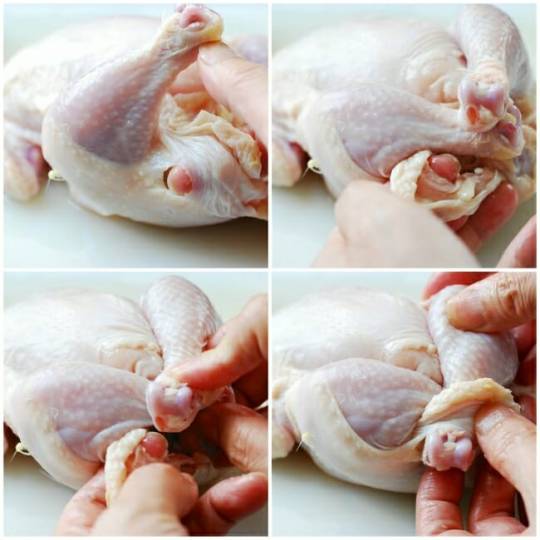
Place the chicken into a large pot with the water
Add the rest of the garlic, ginseng, ginger, jujubes, 1 tablespoon of rice and onion if using
Bring to boil and skim off foam
Cover and boil for 15 minutes
Reduce heat and continue to simmer for 25 minutes
Turn off heat and rest for 10 minutes
If using dipping sauces, mix the ingredients together well and serve in small dishes
Serve whole with fresh chopped green onion
This recipe can be scaled up to include more chickens, add 10 minutes for each one you add.
It is better to use more small chickens than one large one when cooking this dish.
Bibliography:
https://www.koreanbapsang.com/samgyetang/
https://www.maangchi.com/recipe/samgyetang
1 note
·
View note
Text
짜장먄 (jjajangmyeon) - Noodles in Black Bean sauce

(Serves 4)
It is the most popular Chinese-Korean dish. It dates back to 1905, in a restaurant called Gonghwachun (공화춘) that was located in Incheon Chinatown. It was run by an immigrant from Shandong Province in China.
Recently, it has become symbolic to eat jjajangmyeon on Black Day (April 14). This is an unofficial holiday celebrated by single people. It’s like the opposite of Valentine’s Day and White day. There is also a tradition of eating jjajangmyeon on the first day after moving houses.
The word jjajangmyeon comes from the Chinese words 炸酱面 (zhájiàngmiàn) which literally translates to fried sauce noodles
Equipment
Scales or measuring cup
Frying pan
Saucepan
Ingredients
½ cup (240 g) Korean black bean paste (chunjang or jjajang)
½ cup (120g) of vegetable oil
200g pork - chopped into bitesize pieces
1 bulb of onion - thinly sliced
¼ head of cabbage - roughly chopped
1 courgette - cut into ½ inch cubes
1 cucumber - cut into ½ inch cubes
2 stalks of spring onion - sliced thinly diagonally
1 tbsp granulated sugar
1 tbsp cornstarch
1 cup (240g) of water
4 servings of noodles
Instructions
In a frying pan, put the black bean paste and oil and cook over low-medium heat until the oil starts boiling, stirring occasionally
Oil up another frying pan and add the pork and cook on medium heat until it’s no longer pink
Add the onion and stir fry until soft and translucent
Add the cabbage, courgette, cucumber, and spring onion, cook until they’re soft.
Add the black bean paste to the vegetables with the sugar and mix
Add the cornstarch to the water and mix
Cook for 2 minutes then add the starch water and mix
Cook until it thickens
Cook the noodles and serve with the sauce over it
Store in a fridge for 3-5 days
Bibliography:
Icon in heading: https://www.koreanbapsang.com/jajangmyeon-noodles-in-black-bean-sauce/
https://kimchimari.com/jjajang-myeon/
https://futuredish.com/jajangmyeon/
0 notes
Text
된장 찌개 (doenjang jjigae) - Soybean paste stew

(serves 4)
Equipment
Measuring cup or scales
Pot
Ingredients
6 oz (170 g) beef brisket or pork shoulder or loin - sliced into thin strips
4 cup (945 g/945 mL) of water (preferably the water used to rinse rice)
3 tbsp doenjang (soybean paste)
1-2 tsp gochugaru (Korean red chili pepper powder)
1 tsp garlic - minced
1 - 2 potatoes - cubed
1 courgette - cubed
½ bulb of onion - thinly sliced
255 tofu - cut into 1-inch cubes
2-3 stalks green onion - chopped into 1-inch pieces
2 chili peppers - thinly sliced
(optional) 115g enoki mushrooms
Instructions
Preheat a pot with oil in it. Add the meat and cook until brown over medium-high heat while stirring.
Add the potatoes and cook and stir for 2 minutes
Add the water, soybean, and gochugaru and bring to a boil
Add the garlic, courgette, and onion and boil for 1 minute
Add the mushroom and tofu and boil for 3 minute
Add the green onion and chili peppers and boil for another 1 minute and remove from heat
Serve with rice
This can be refrigerated or frozen for a few days
Bibliography:
Icon in heading: https://www.beyondkimchee.com/doenjang-jjigae/
https://www.koreanbapsang.com/doenjang-jjigae-korean-soy-bean-paste/#wprm-recipe-container-6509
https://mykoreankitchen.com/doenjang-jjigae/#wprm-recipe-container-21885
https://www.christinascucina.com/doenjang-chigae-aka-korean-bean-paste/#mv-creation-108-jtr
0 notes
Text
K-BBQ History

KBBQ can be traced back to Goguryeo era (37 BC-668 AD) with the creation of “maekjeok” by the nomadic Maek tribe (skewers roasted over a fire) which was later renamed bulgogi.
Later in the Joseon dynasty, neobiani (thin, marinated and charbroiled beef slices) were a favourite of the royal family.
From 57 BCE to 668CE Buddhism was the state religion of Korea and as a result meat eating was banned. This led to banchan (side dishes - in this case, vegetable ones) becoming a staple of the Korean diet.
After the Mongol invasion and rule from 1231-1259, meat dishes were reintroduced into the food culture alongside banchan but prices of meat rocketed during the Japanese invasion from 1910-1945 which once again resulted in a decline of meat consumption.
Following Japanese occupation, Korea was able to raise more cattle for beef to make bulgogi more popular. The use of slicing machines imported from America to give thinner cuts of meat that cooked faster, and an abundance of sugar to sweeten the marinade from sugar factories further increased bulgogis popularity as a dish.
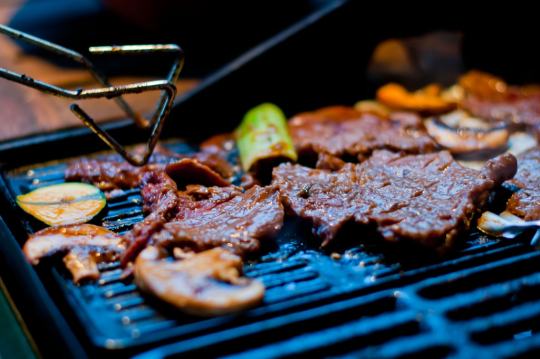
Alcohol has been paired with grilled dishes since the Joseon era. Korean drinking culture and etiquette was also introduced during Sohak (lesser learning) which set strict rules for how people should behave and respect others when drinking based on factors such as age, gender and social class.
Drinking was however enjoyed by all regardless of class.
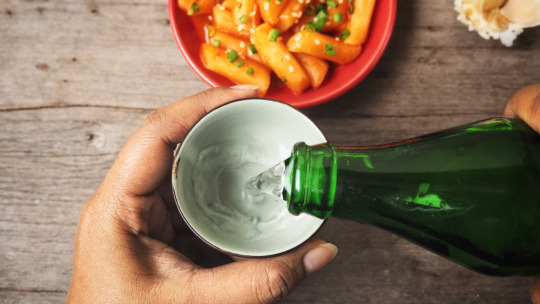
Sorry this one is only short, committee are very busy with hand ins at the moment :((
Posted by Leo
Bibliography
https://foodworthwritingfor.com/2018/07/24/the-history-of-korean-barbeque-banchan-and-dry-aging/#:~:text=Korean%20barbeque%20is%20typically%20slices,and%20lettuce%20to%20be%20eaten.&text=Bulgogi%20and%20its%20origins%20date,a%20skewered%20meat%20called%20maekjeok.
https://nextshark.com/korean-bbq-history/
0 notes
Text
핫도그 (hatdogeu) - Hotdogs/Corndogs

(serves 4-6)
There are many variations of the hotdogs however the version we are making is the most popular and the original.
Equipment
Wooden skewers
Sieve
Trays
Deep fryer or pan with oil
Ingredients
2 - 3 Hot Dog sausage - halved (so there are 4-6 pieces)
4 - 6 mozzarella pieces - cut to the size of half a sausage, refrigerated
2 cup (250 g) all-purpose flour (or bread flour) - sieved
2 tbsp (30 g) granulated sugar
½ tsp salt
2 tsp baking powder
¾ cup (180 mL / 180 g) milk
1 egg
Panko bread crumbs
Oil for frying
Extra sugar for coating
Condiments (usually ketchup and mustard)
Instructions
Mix the flour, sugar, salt, baking powder, milk, and egg together in a large tray. Cover with cling film or a wet towel until the batter doubles on size If it is too runny, add more flour.
Preheat the deep-fryer to about 190℃
Skewer the sausage lengthways and then skewer the cheese lengthways on the same skewer. Place back in a fridge
Put the panko in a tray or plate.
On a separate tray or plate, sprinkle a layer of sugar
Take the sausage out and roll it in the batter. Make sure all spaces are cover otherwise the cheese will leak out while frying.
Completely cover in the panko crumbs, squeezing it to make sure the crumbs stick on.
Deep fry until completely golden brown
Roll in the sugar while still hot and drizzle with ketchup and mustard (or any condiments)
Popular variation:
Just sausage
Just cheese
Cheddar instead of mozzarella
Tteokbokki instead of hot dog and cheese - boil before skewering
Jalapenos - finely dice the jalapenos and add to the batter
Cheetos/Doritos coating - crush up and add to the breadcrumbs
Instant noodles - crush up to small pieces (but not to dust). Dip in batter then roll in crushed noodles, making sure to press it into the batter. Lastly, coat in the breadcrumbs
Potato/Chips - cut potatoes into ½ inch cubes (cut chips in half). Dip in batter then roll in the potato/chips, making sure to press them into the batter. Lastly, coat with breadcrumbs. (these ones are called gamja (감자) hotdog. Gamja means potato in Korean)
Bibliography:
Icon in heading: https://www.reddit.com/r/FoodPorn/comments/fak60k/these_koreanstyle_corn_dogs/
https://kirbiecravings.com/korean-hot-dogs/
https://www.youtube.com/watch?v=imi8YDvyWn0&ab_channel=Nino%27sHome
https://www.youtube.com/watch?v=hhwtKx9MXZA&ab_channel=SeonkyoungLongest
https://seonkyounglongest.com/cheese-corn-dogs/
https://www.youtube.com/watch?v=I-q_zN5yKLY&t=28s&ab_channel=%EB%9A%A4%EA%B8%B0ddulgi
https://www.youtube.com/watch?v=X8yDDcFZV3g&ab_channel=AmnaJudeSarah
https://www.youtube.com/watch?v=AXGpn7pG63M&t=123s&ab_channel=COOKAT
https://www.youtube.com/watch?v=xMTb669y2Ko&t=7s&ab_channel=%EC%9A%B0%EB%AF%B8%EC%8A%A4%EB%B2%A0%EC%9D%B4%ED%82%B9Umi%27sbaking
https://www.youtube.com/watch?v=NH-s52JpaMo&ab_channel=SoonFilms
2 notes
·
View notes
Text
화이트데이 - White Day
White day takes place on the 14th of March - one month after Valentines day.
In Korea Valentine's day is said to be for women to give gifts to men, and then this reversed on white day so the men give women gifts. White day was born largely from the fact that it is customary to reciprocate if you receive gits. Therefore, this can also mean that if someone receives a gift it may not necessarily be a declaration of love, but may just be due to an expectation.

White day started in Japan but is now also celebrated in Korea, Taiwan, Hong Kong, China and Vietnam.
In 1978, the Japanese National Confection Industry Association promoted the idea of an “answer day” to Valentines day as it was tradition for only men to receive gifts - allegedly this came from a letter sent to a magazine where a woman said it was unfair and women would even appreciate something as small as marshmallows - and so a day in which the roles could be reversed was devised. A new candy of marshmallow filled with chocolate was also created for this day which led to an initial name of Marshmallow Day. It was suggested to change the name to something more open ended so that other gifts could be given and White Day was chosen to still reference the marshmallows.
Fun fact: chupa chups are the most popular candy on white day.

As well as Valentines day and White day, there are other unofficial holidays in Korea that fall on the 14th of each month.
January - Candle day/diary day
February - Valentines
March - White day
April - Black day
May - Yellow day/rose day
June - kiss day
July - Silver day
August - Green day
September - photo day/music day
October - Wine day
November - Movie day
December - Hug day
Out of these, however, black day is possibly the only one widely known - other days are kept within relationships rather than widely advertised and celebrated.

Black day is the day for single people. Those who did not receive a gift on either of the two previous days may wear black for the day and go to eat jjajangmyeon (black bean noodles) to mourn the love that they do not have. Some restaurants and cafes have specifically created black food for this day such as this muffin from JavaCity and across the country sales of black coffee soar.
In recent years Black day has seen more friends eating together to celebrate their singleness rather than wallowing in misery but the day’ existence is blamed on Korea having such a couple-centric society that treats being single as an undesirable thing to be.
Researched and posted by Leo ^.^
https://www.koreanclass101.com/blog/2019/02/27/white-day/
https://blog.inspiremekorea.com/inspired-by-korea-series/what-is-white-day-in-korea/
https://www.daysoftheyear.com/days/white-day/
https://www.forbes.com/sites/adelsteinjake/2018/03/13/how-japan-created-white-day-east-asias-alternate-valentines-day/?sh=521ee53b348b
https://matadornetwork.com/abroad/the-14th-of-every-month-in-south-korea-is-a-holiday/
https://www.seriouseats.com/2019/04/introduction-to-black-day.html
0 notes
Text
빙��� (bingsu) - Shaved ice

(Serves 1)
(This is how to make bingsu with the ice shaving machine)
You may have also heard it being called patbingsu (팥빙수). Pat means red bean however nowadays they may have other toppings like fresh fruit, cream/ice-cream, and condensed milk. They also have flavoured bingsu like coffee and green tea.
Equipment
Ziploc bag
Ingredients
2 cups milk (any kind, almond, fat-free)
½ tsp vanilla extract
Condensed milk (optional)
Toppings of your choice
Instructions
Add the milk and vanilla extract into a Ziploc bag and freeze flat. (You can also add the condensed milk in this instead of some of the milk)
Crush the frozen milk with your hands to the texture you like and place into a bowl
Pour the condensed milk over it and arrange the toppings on top
To make coffee or green tea bingsu, make one cup of the drink and one cup of water and freeze instead of the milk.
Bibliography:
Icon in heading: https://kenh14.vn/can-canh-bingsu-mon-kem-han-quoc-dang-khien-gioi-tre-viet-me-man-20160216223849692.chn
https://mykoreankitchen.com/patbingsu-korean-shaved-ice/#wprm-recipe-container-15012
https://www.youtube.com/watch?v=Fe8z1cAxrG4&ab_channel=SugarCrystalKitchen
https://www.youtube.com/watch?v=WJXuIJiRE8M&ab_channel=ModernPepper
https://www.youtube.com/watch?v=RMudtHk4_Kk&ab_channel=KindofCooking-SousVide%2CRecipes%2CandMore
https://www.youtube.com/watch?v=RrtuTfUualk&ab_channel=ModernPepper
https://en.wikipedia.org/wiki/Patbingsu
1 note
·
View note
Text
Drinking Culture

It’s no secret that Koreans drink a LOT. They often go drinking after work or university even if it's a workday, and it’s common most early morning to see people struggling their way home. Refusing to go drink can make you an outcast from social groups because of how popular it is.
Fun facts
South Korea consumes the largest amount of alcohol in Asia (10.9L per capita aged over 15). The second is Vietnam with 8.7L and the third is Thailand with 8.3L which puts Korea ahead by quite an amount.
Soju is a hard liquor and South Korea is the number one country for hard liquor consumption in the world with an average of 13.7 shots per week per person of legal age in 2014. (Russia has 6.3 shots, less than half of what Korea consumes).

Drinking etiquette
You never pour for yourself.
The first drink is usually poured by the eldest/most superior.
When someone older/more superior than you is pouring for you, you must hold your glass with two hands and you shouldn’t drink until the older person cheers (geon bae!!!)
After that, the youngest person pours for everybody. They must pour with both hands.
You should always accept the first drink offered to you unless you have a medical or religious reason.
The first drink should be downed in one. After the first, you can start pacing yourself or refusing in a polite manner that won’t offend anyone - the easiest way to do this is to leave your cup partially filled.
Cups should only be refilled when they are totally empty.
Younger people can’t look at the older people when drinking, they must turn the other way and cover the view of your mouth and glass with your hands.
Opening soju bottles
Shake the bottle
Turn it upside down and hit the bottom of the bottle with your elbow.
Then open the bottle and take the lid off
Some people make a ‘V’ with their index and middle finger and hit the neck of the bottle with the gap between the V. They say this will get rid of the impurities in the drink

Drinking phrases
Do you want to get a drink?
한잔해? - han jan hae?
(informal) 한잔할래? - han jan hal lae?
(formal) 한잔할래요? - han jan hal lae yo?
Get a drink
(formal) 한잔해요? - han jan hae yo?
(more formal, more polite) 한잔받으세요? - han jan bad eu se yo?
Cheers!
건배!!! - g/keon bae!!!
짠!!! - jjan!!!
Drink!
마셔라!!! - ma syeo ra!!!
One shot!
원샷!!! - one shot
Let’s go to another bar
(informal) 이차가자 - e cha ka ja
Common places to drink
Jumak (주막) - bar based on korean culture and sells traditional anju
Hof house - bar that sells relatively inexpensive alcoholic beverages and international dishes
Pojangmacha (포장마차) - tent bar
Convenience stores are usually open 24/7 as well

Popular Korean alcoholic drinks
Soju (소주) - has a 16.8 - 53% alcohol by volume. It is usually drank straight but can also be mixed with beer to make somaek (소맥).
Makgeolli (막걸리) - it’s the oldest alcoholic drink in Korean and is usually 6-9% alcohol by volume. In Korea, it is unpasteurized but exported makgeolli are pasteurized to have a longer shelf-life which makes it lose some of it’s flavour
Cheongju (청주) - clear refined rice wine. Is 14% alcohol by volume. In the 12th century, cheongju was made in the royal court whereas Takju - 탁주 (milky unrefined rice wine like makgeolli) was more common among commoners.
Anju
In the UK, we normally eat and drink separately. We may drink wine or beer while eating but we don’t usually take shots of vodka while eating, however in Korea, it’s common to eat when drinking. The food eaten while drinking is called anju (안주)
Different anju goes with different drinks.
Soju - stews (jjigae - 찌개), soups (tang - 탕), stir-fried food (bokkeum - 볶음), pork belly (samgyeopsal - 삼겹살), offal (gopchang - 곱창), chicken feet (dakbal - 닭발) and the last viscus of cattle (makchang - 막창)
Makgeolli - Korean pancakes (buchimgae - 부침개 or jeon - 전), kimchi dishes, pork shoulder (bossam - 보쌈), raw fish and oysters (any word with hoe - 회 at the end is raw)
Cheongju - confections (dasik - 다식 or jeonggwa - 정과), deep-fried vegetables (bugak - 부각), Korean Pancake, beef (like bulgogi - 불고기, hanu - 한우 and sanjeok - 산적), raw food and Korean hot pot (jeongol - 전골)
Maekju/beer (맥주) - dried jerky (po - 포) and dried seafood (like squid, nogari - 노가리 and jwipo - 쥐포), deep-fried food (twigim - 튀김), seasoned nuts, corn cheese, fried chicken and pizza. (Eating fried chicken with beer/maekju is called 치맥-chimaek)
Wine - cheese platter and steak
Anju is made to be shared, you don’t order a plate just for yourself. Everything is social when it comes to Korean drinking

Korean drinking games (suljari game - 술자리게임)
Flicking the bottle cap
Participants take turns flicking the soju cap tail
The winner is the one who flicks the tail off the cap
All failed attempts must drink
Hi low
Participants takes turn guessing the number on the soju lid and the winner of the bottle cap will be holding the cap and say whether it’s higher or lower
The winner is the one who guesses the number and everyone else (except the cap holder) has to drink
3-6-9 (Sam-Yuk-Gu)
Taking turn, everyone says a number, counting up (so person 1 says “one”, person 2 says “two”)
However, for every number containing the digits 3, 6, 9, the person will clap instead of saying the number (so 12 will NOT have a clap but 13 WILL)
If the number has two of the number (e.g. 33, 36, 39) the player must clap twice.
The person who messes up will drink
Titanic/Submarine
Fill a tall glass about ¾ full with beer. Place a shot glass in the glass so that it's floating in the beer.
Take it in turns adding soju into the shot glass (you can add as much or as little as you want but you need to add something in there)
The person to make it sink will be the one drinking the whole glass.
Baskin Robbins 31
In turns, each person says up to 3 consecutive numbers, the next person will carry on the sequence (e.g. person 1 may say “1”, person 2 may say “2, 3, 4”
The loser is the one who has to say 31
Sense (noonchi - 눈치) game
People in a random order, people shout out numbers in consecutive order.
The losers are the ones that both say the same number at the same time (so it person 2 and 5 both sound out 4 at the same time, they both drink)
OR the last one to say a number (so if everyone but person 3 says a number, person 3 has to drink)
Image game
The first person asks a question about “who is/who’s most likely to…”
Everyone else votes by pointing
The loser is the one who has the most votes
King
From a deck of cards, remove the King and a card for each person (minus the king). Each card must be a different number
Shuffle the pile of cards and each person chooses one.
The king will announce himself and order 2 random numbers to do anything without knowing who is what number
If the person doesn’t follow orders, they have to drink
There are many more games like Mandu, Bunny Bunny, Fool’s (babo - 바보) game and Frying Pan.
Researched by Vicki and Posted by Leo :)
References
https://en.wikipedia.org/wiki/Drinking_culture_of_Korea
https://en.wikipedia.org/wiki/Korean_alcoholic_drinks
https://www.90daykorean.com/drinking-culture-in-korea/
https://www.youtube.com/watch?v=glWlwxgbwb4&ab_channel=sweetandtastyTV
https://www.youtube.com/watch?v=cJqeKTel7R0&ab_channel=BuzzFeedVideo
https://en.wikipedia.org/wiki/Anju_(food)
https://matadornetwork.com/read/korean-drinking-traditions/
https://medium.com/@xreasons/8-reasons-why-south-koreans-drink-more-than-anyone-7267219feaa1
https://thesmartlocal.com/korea/korean-drinking-culture/
https://www.studocu.com/blog/en/the-best-south-korean-drinking-games
https://10mag.com/10-korean-drinking-games-you-have-to-try/
http://kissmykimchi.com/2011/04/kmk-korean-drinking-games.html/
https://www.youtube.com/watch?v=0f7d5VRhLls&ab_channel=SimonandMartina
2 notes
·
View notes
Text
순두부 찌개 (sundubu/soondubu jjigae) - Spicy soft tofu stew

(Serves 2)
Equipments
Measuring cup
Scales
Frying pan
Small pot or ttukbaegi
Ingredients
Jjigae Paste
1 tbsp vegetable oil
2 tsp sesame oil
3 oz (85 g) minced pork (or beef)
2 cloves garlic - minced
2 tsp gochugaru (Korean red chili flakes)
½ tbsp soy sauce
Salt (to taste)
Soondubu jjigae
1 cup water (or anchovy stock)
(optional) 1-2 shiitake mushroom - sliced
(optional) 5 clams
350g (12oz) silken/extra soft tofu
(optional) ½ tbsp Korean fish sauce
(optional) ½ tsp saewujeot - 새우젓 (minced fermented/salted shrimp)
Black pepper (to taste)
1 egg
1 stalk of green onion - thinly sliced diagonally
Instructions
Heat a frying pan over medium-high heat with vegetable and sesame oil. Once the oil is hot, add the pork, garlic and gochugaru and stir-fry for 3-4 minutes. Reduce heat to medium-low
Add the salt and soy sauce, mix and take off the heat. (if you make a larger batch of this paste, you can freeze it for 4-6 weeks)
Add this paste to a small pot with the water (this is usually done in a ttukbaegi - a clay pot) and cook on medium-high heat.
Once it starts to boil, add the mushroom and clams. Mix
Add the tofu and break it apart with your spoon
Add the fermented shrimp, fish sauce and black pepper. Cook for another 4-5 minutes.
Remove from heat and add green onions and egg while still boiling hot.
Serve with rice
The jjigae paste can be frozen for 4-6 weeks so it might be better to make a larger batch.
The actual stew can probably be refrigerated for a few days
References
Image: https://www.cookerru.com/sundubu-jjigae/
https://futuredish.com/korean-sundubu-paste-make-jjigae-in-5-min/
https://www.koreanbapsang.com/kimchi-soondubu-jjigae-soft-tofu-stew-kimchi/#wprm-recipe-container-7691
https://mykoreankitchen.com/sundubu-jjigae/#wprm-recipe-container-9189
https://kimchimari.com/sundubu-jjigae-soft-tofu-stew/#wprm-recipe-container-10190
0 notes
Text
민담 - Folktales
Folktales are an important part of every culture as they show a glimpse of ideals and thoughts of people from the past. They are often short and fairly simple, to make them easy to tell and remember, and nowadays they are mostly told as stories to children.
Some of the folk tales you can read are:
Wrestling with a Goblin / Dokkaebissireum
The Fox Sister / Yeounui
The Salt Seller and the Fox
The Rabbit’s Judgement
Silkworm
The tale of SimCheong
The Green Frog
The Tiger and the Dried Persimmon
In this post we have already put the last 3 from the list above.
The tale of SimCheong (심청 전 - simcheong jeon)
In ancient times, there once was a poor couple. The husband, Sim Hyeon, was blind and they were trying to have a child. After many years of trying and praying, they finally gave birth to a beautiful daughter they called SimCheong however the wife died due to birth complications. SimCheong grew up to be a loving and filial daughter
One day, SimHyeon fell into a ditch, unable to get out due to his blindness. Luckily a monk was passing by and offered to help him out of the ditch and to pray for his eyesight back in exchange for 300 sacks of rice donated to his temple. SimHyeon agreed in a moment of relief that someone was helping him however he soon realised that he could not fulfill his part of the deal. He told his daughter what had happened and asked her what they could do. Who knows what Buddha would do to them if they didn’t follow through with their promise.
That night, SimCheong dreamed of her mother. She told her to go to the harbour were merchants are looking for a young maiden in exchange for money. SimCheong did as her mother instructed but asked the merchants for 300 sacks of rice to be sent to the temple in her father’s name instead of money. They did as they were told however her father’s eyesight did not return.
The merchants needed a young maiden as they had displeased the Dragon King of the East Sea who was now sending storms to sink their ships. To appease him, they needed to sacrifice a young maiden.
They dressed her up in a wedding hanbok and bound her worried that SimCheong would go back on her promise. Together with the merchants, they set sail and once they had reached far enough into the water, SimCheong leaped into the water sacrificing herself. The men wept as they had never seen such bravery.
Underwater, SimCheong found she could breathe and as she sank deeper into the waters, she saw a bright light. It was the Dragon King’s palace. The Dragon King’s servants swam up to release her from her bonds and escorted her to the palace. She lived there for some time however she was getting homesick and wished to see her father. The Dragon King noticed her sadness and she told him her story. Moved by her selflessness and filial piety, he allowed SimCheong to return to the surface in the form of a giant lotus flower.
The giant lotus flower was found by a river and gifted to the recently widowed king to lift his spirits. It worked and he had it placed in his bedroom where he could stare at its beauty all day. At night, SimCheong would emerge from the flower and look for her father, and every dawn, she would return back to the flower.
One night, the king saw the beautiful girl by the flower and asked her who she was. She tried to transform into the flower however it had disappeared and after explaining she was the girl living in the flower, the king proposed to her and they got married. However, he too soon noticed the sadness in her and asked her what she wanted. She replied that all she wanted was a banquet to be held for all blind men in the kingdom
The king did as SimCheong requested. The banquet lasted 3 days and everyday SimCheong searched for her father however she couldn’t find him. On the last day, she overhears people yelling at the gate. There she saw the guards turning away a latecomer to the banquet. She begged for him to be let in as it was her father. Her father was shocked to hear her voice and exclaimed “Is this a ghost or has my late daughter come back from the dead?”. Overwhelmed with happiness, he opened his eyes to find he could see again. They lived together in happiness from that day on and any blind man that laid their eyes on her regained their eyesight.
(Fun fact: SimCheong is mentioned in Hwasa’s Twit)

The Green Frog (청개구리 - chong gaekuri)
Once upon a time, the green frog lived with his widowed mother in a small pond. The green frog never listened to his mother and always did the opposite of what she said. The mother frog was worried and embarrassed by the green frog. “Why can’t he be like the other frogs? Why can’t he respect his elders? Why can’t he do as he’s told?” she would say to herself. She was worried about what would happen when she was gone so she tried to break his bad habits by scolding him everytime he misbehaved. However, the green frog kept doing what he wished.
Eventually, she became sick from growing old and worrying about her son but the son still did as he wanted.
Finally, when the mother knew she was going to die, she called her son to her side. She wanted to have a proper burial in the mountains but knew the frog always did the opposite of what she told him to do, so she told him to not bury her in the mountains, she wanted to be buried in the bank of the river.
The green frog promised he would bury his mother in the riverbank
4 days later, she died and the green frog was sad and blamed himself for his mother’s death. He knew it was too late to undo his past however he resolved to become a good frog and finally listen to his mother.
Despite knowing that it was unwise to bury his mother on the river bank, he did as his mother told him and everytime it rained, he stood watch over her, being that the water didn’t rise. During monsoon season, the river rose and rose until it overflowed to the bank and washed his mother’s grave away.
The green frog cried and cried for his mother and that’s why the frog cries when it rains.
(the reason why the story is called the green frog is because Chong which means green can also means plea. Therefore it's a play on words. It can mean “The Green Frog” or “The Frog who Pleads).

The Tiger and the (Dried) Persimmon (호랑이 와 곶감 - horangi wa kot gam)
There lived a tiger in a forest. He was very very scary and very very hungry because all the animals ran away from him. So he went to the village to find food.
In the village, he heard a child crying and wanted to eat him but before he could, the child’s grandmother tried to scare the child into being quiet by exclaiming “Look! The tiger is right outside, ready to take you away if you're not quiet” however the child kept crying without an ounce of fear. The tiger was impressed with the child’s courage as it had never seen a being not scared of him but was still hungry and wanted to eat the child but just before he could pounce he heard the grandmother say, “Look! A permission” and the child stopped crying instantly.
“Permission? What’s a permission?” the tiger thought, “It must be more frightening than me!”
At that moment, something fell on his back. “Oh no, it must be the persimmon,” thought the tiger and he ran back into the forest. The thing on his back was a thief that had accidentally jumped on the tiger’s back while trying to get away. The thief was terrified of the tiger and had to grab a tree branch to get off the tiger’s back.
The tiger was relieved once he felt nothing on his back and he never went to the village again and the thief never stole anything again.

Researched by Vicki and written by Leo ^.^
Bibliography:
http://www.sejongsociety.org/korean_theme/korean_folk_tales/
https://www.youtube.com/watch?v=0wNNrTMuTG8&ab_channel=DoranK
https://en.wikipedia.org/wiki/The_Tale_of_Shim_Chong
https://www.youtube.com/watch?v=vsTvZw7odoc&ab_channel=HelloKids
https://www.youtube.com/watch?v=1qoVaE93aXU&ab_channel=HelloKids
https://www.youtube.com/watch?v=_wK-SooG0tA&ab_channel=LearningEnglishOnlineUcan.Vn
https://www.youtube.com/watch?v=GoeCPy70lCY&ab_channel=HelloKids
1 note
·
View note
Text
길거리토스트 (gilgeori toasteu) - Korean street toast
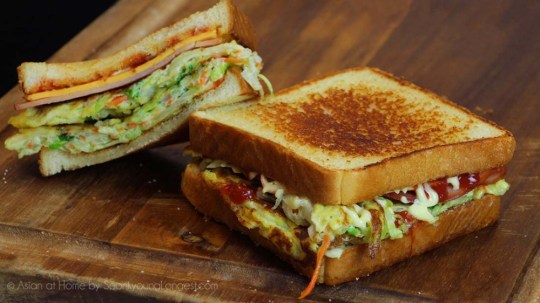
(Serves 1)
Equipment
Frying pan
Ingredients
2 slices of bread (usually milk bread but brioche or white sandwich bread is also common)
60g (2 cups) Cabbage - shredded
½ carrot - grated
2 green onion - thinly sliced
2 egg
Cheese
Salt (to taste)
Pepper (to taste)
Ketchup (to taste)
Mayonnaise (to taste)
Butter
(optional) ham, bacon, bulgogi, onion, gherkins, sweetcorn
Instructions
Mix the carrot, green onion, onion, sweetcorn together in a bowl (you can also add the cabbage here)
Add the egg and salt and pepper and combine all together
Butter a frying pan and fry the eggy mixture on medium heat for about 2-3 minutes then flip and cook for another 2-3 minutes. Try to the shape the egg into the shape of your bread
Cook any other ingredients like the meat.
Butter both sides of each slice of bread and fry on the buttered frying pan until your desired colour.
Assemble by sandwiching the egg, meat, cabbage, gherkins, cheese and ketchup, and mayo between the pieces of toast
Bibliography:
Icon in heading: https://seonkyounglongest.com/korean-street-toast/
https://www.maangchi.com/recipe/street-toast
https://mykoreankitchen.com/korean-toast/
https://kimchimari.com/korean-street-toast/
https://cooking.nytimes.com/recipes/1021096-gilgeori-toast-korean-street-toast-with-cabbage-and-egg
0 notes
Text
미신 - Superstition
Korea as a lot of unique superstitions, but here are some of the more well-known ones that some people still believe in today.
Sleeping with a fan on
The most popular Korean superstition is the fan death (선풍기사망설 - seonpunggisamangseol). The superstitions may be started in 1927 in a newspaper article that claimed electric fans can cause nausea, facial paralysis, and asphyxiation. This is because they believe the fan will circulate the stale air causing sleepers to choke on the carbon dioxide they breathe out. However, if you leave the windows and door open to create airflow, you’re safe.

Trimming fingernails at night
The belief is that if you trim your nails at night, mice will come and eat the clippings and transform into your form and steal your soul. The truth behind the superstition is that back when there was no electricity and light, there was a high risk of hurting your fingers so clipping your nails at night was discouraged.

Chopstick
The way you hold your chopsticks can indicate the time taken to get married. The closer it is to the tip, the longer you have to wait to get married.
It is also bad luck in many Asian countries to have your chopsticks sticking upright in the bowl because they look like incense. Incense is used to honour and mourn deceased family members so placing your chopsticks upright will bring you misfortune.
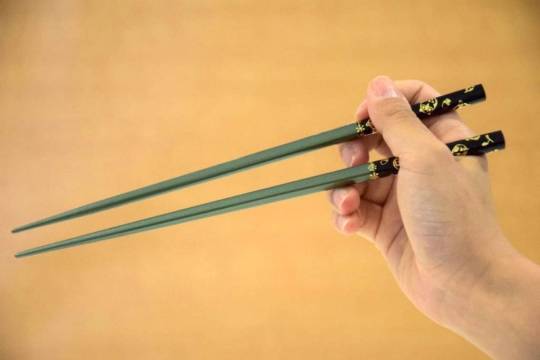
Whistling at night
Koreans believe that whistling at night invites snakes and ghost. This is actually a popular superstition in Asia and in Aboriginal culture.
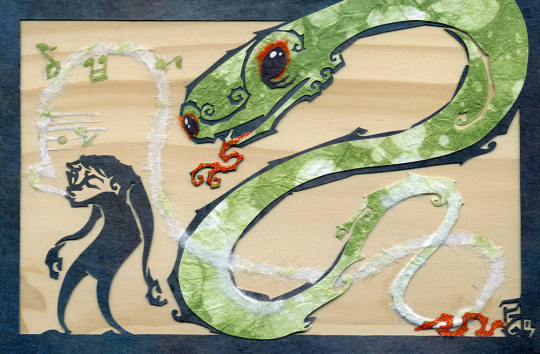
Washing your hair
Washing your hair on the first day of the year (New Years) will wash your good luck away. You also shouldn’t wash your hair before an exam as it washes away the knowledge.

4
In a lot of Asian cultures, the word for four (사 - sa) sounds like the word for death and is extremely unlucky so a lot of buildings skip the 4th floor or is labelled “F” instead.

Dream pigs
In many Asian cultures, pigs are considered a symbol of wealth so dreaming of them will mean fortune will soon come to you.
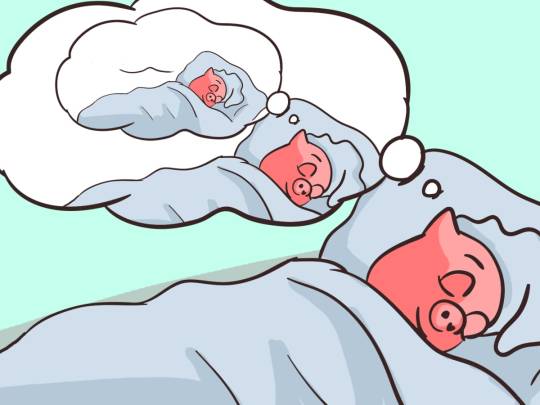
Writing names in red
Writing a name in red will cause that person to die as dead family member’s names are usually written in red on records. This is a popular superstition across much of Asia.

Shoe gifts
DO NOT BUY SHOES AS A GIFT. Unless you want them to leave you. It is believed that it causes the person to run away from you forever.

Feeding wings to someone
A girl should avoid feeding wings to their boyfriend wings from any bird because it will make the husband fly away/have an affair.

Food knowledge
Before going to exams, students will eat taffy (엿 - yeot), or any sticky food because it makes the knowledge stick in the student’s mind. On the other hand, they will avoid eating slippery foods like noodles and seaweed soup because it causes the knowledge to slip out your brain.

Jumping over babies
Jumping over babies will prevent the growth of the baby meaning they’ll be short instead of tall.
Also, unless you’re taking part in El Colacho in Spain, maybe don’t jump over babies in general. It’s not safe.
https://www.nationalgeographic.com/travel/article/el-colacho-baby-jumping-festival-murcia-spain

Butterfly blindness
Koreans believed that touching butterflies and then touching your eyes will cause you to go blind so make sure to wash your hands after touching a butterfly.

Moving day
If you’re moving house, pick a fortuitous date otherwise evil spirits will follow you to your new house. This is because you will block the spirits from going to heaven if you move on certain days. To find the right days, they use the evil spirit-free day calendar (손없는날 달력 - soneomneunnal dallyeok - here’s a link: http://www.bojagicard.com/bojagicard/doc/menu/wedcard/calendar.html).
Another superstition is to not clean your house before moving because the spirits will see you’re moving and follow you.

Bibliography:
http://www.banana-mag.com/all-things-azn/2020/4/22/asian-superstitions-issue005
https://theculturetrip.com/asia/south-korea/articles/10-superstitions-that-koreans-still-believe-today/
https://www.90daykorean.com/korean-superstitions-that-just-may-save-your-life/
https://www.soompi.com/article/1222973wpp/13-unique-korean-superstitions-may-not-known
https://www.koreatravelpost.com/korean-superstitions/
0 notes
Text
칼굯수 (kalguksu) - Knife-cut noodles

(Serves 4)
Equipment
Scales or measuring cups
Grater (optional)
Rolling pin
Plastic wrap
Cooking pot
Ingredients
Dough for noodles
2 cups (120 g) all-purpose flour - sieved
½ cups (120 mL or 120 g) of water
½ tsp salt
Soup broth
6 cups (1420 mL or 1420 g) anchovy broth (or chicken broth, beef broth or water)
1 tsp light soy sauce
1 clove of garlic - minced
1 tsp salt
1 courgette - chopped into 1-2 inch pieces and thinly sliced (or just grated)
1 bulbs of onion - thinly sliced
2 stalks of green onion - thinly sliced diagonally
(optional) meat
Instructions
Mix flour, water, and salt together and knead. Add flour if too wet and add water if too dry.
Flour a surface and transfer the dough onto it and knead it. Cover in plastic wrap and let sit for 30 minutes
Knead the dough for 2 minutes on a floured surface and roll it out into a square or rectangle using a floured rolling pin until its thin (around 3mm)
Fold one side 4 times (so fold one quarter over, then fold it again and again)
Gently cut it about 1 cm thick along the short side. (if you cut too hard, the noodles with stick together
Sprinkle with flour and toss it so they are separated and covered in flour

Boil broth/water with soy sauce, garlic, and salt over medium heat
Cook meat
Once boiled, add the courgette, onion and green onion until soft (around 2 minutes)
Add the noodles (3-5 minutes for homemade noodles or as instructed if store brought)
Serve
This should be eaten straight away because the noodles will quickly absorb the liquid
Bibliography:
Icon in heading: https://futuredish.com/kalguksu-noodles/
https://kimchimari.com/kalguksu-korean-knife-cut-noodle-soup/
https://cookidoo.thermomix.com/recipes/recipe/en-US/r402079
https://mykoreankitchen.com/kalguksu/
0 notes